Paleogene Geomorphy and Formation Process of the Diaoyu Islands Folded-Uplift Belt, East China Sea Basin: Insights of the Dynamics of Subducting Slab on the Control of Tectonic Evolution in Back-Arc Basins
Abstract
1. Introduction
2. Geological Setting
2.1. Mesozoic Tectonic Evolution
2.2. Cenozoic Tectonic Evolution
3. Data Sets and Methods
3.1. Data Sets
3.2. Determining the Eastern Boundary of the Paleogene Prototype Basin in the Eastern Depression Zone
4. Results
4.1. Identification of Seismic Facies at the Eastern Margin of the Paleogene Prototype Basin in the Xihu Sag
4.2. Proposal of the Eastern Boundary of the Paleogene Prototype Basin in the Xihu Sag and the Paleogene Geomorphy of the DIFUB
4.2.1. Gravity Anomalies, Magnetic Anomalies, and Basin Boundary Proposal
4.2.2. Comprehensive Analysis of the Paleogene Geomorphy of the Diaoyu Islands Paleo-Uplift
4.3. Magmatic Rocks Within the DIFUB
5. Discussion
5.1. Formation and Evolution of the DIFUB
5.1.1. Exhumation of the ECSSOMU and Formation of the Paleogene Prototype Basin in the Eastern Depression Zone
5.1.2. Magmatic Deformation of the Eastern Margin of the Prototype Basin in the Eastern Depression Zone
5.1.3. The Influence of the Philippine Sea Plate on the Late-Stage Evolution of the DIFUB
5.2. The Influence of the ECSSOMU on the Sedimentary System of the East China Sea Basin
5.2.1. Middle Eocene
5.2.2. Late Eocene
5.2.3. Oligocene
6. Conclusions
Author Contributions
Funding
Institutional Review Board Statement
Informed Consent Statement
Data Availability Statement
Acknowledgments
Conflicts of Interest
References
- Bohacs, K.M.; Carroll, A.R.; Neal, J.E.; Mankiewicz, P.J. Lake-Basin Type, Source Potential, and Hydrocarbon Character: An Integrated Sequence-Stratigraphic-Geochemical Framework. AAPG Stud. Geol. 2000, 46, 3–34. [Google Scholar]
- Back, S.; Strozyk, F.; Kukla, P.A.; Lambiase, J.J. Three-dimensional restoration of original sedimentary geometries in deformed basin fill, onshore Brunei Darussalam, NW Borneo. Basin Res. 2008, 20, 99–117. [Google Scholar] [CrossRef]
- Pilcher, R.S.; Kilsdonk, B.; Trude, J. Primary basins and their boundaries in the deep-water northern Gulf of Mexico: Origin, trap types, and petroleum system implications. AAPG Bull. 2011, 95, 219–240. [Google Scholar] [CrossRef]
- Dai, S.; Bechtel, A.; Eble, C.F.; Flore, R.M.; French, D.; Graham, I.T.; Hood, M.M.; Hower, J.C.; Korasidis, V.A.; Moore, T.A.; et al. Recognition of peat depositional environments in coal: A review. Int. J. Coal Geol. 2020, 219, 103383. [Google Scholar] [CrossRef]
- Liu, H.; Xu, C.; Gao, Y.; Lin, H.; Qiu, X.; Ji, Y.; Wang, X.; Li, L.; Meng, J.; Que, X. Source-to-sink system and hydrocarbon source rock prediction of underexplored areas in rifted lacustrine basins: A case study on northern lows in ZhuⅠDepression, Pearl River Mouth Basin. Oil Gas Geol. 2023, 44, 566–583, (In Chinese with English abstract). [Google Scholar]
- Zhu, Z.; Yan, Y.; Zhao, Q.; Carter, A.; Amir Hassan, M.H.; Zhou, Y. Geochemistry and paleogeography of the Rajang Group, Northwest Borneo, Malaysia. Mar. Pet. Geol. 2022, 137, 105500. [Google Scholar] [CrossRef]
- Guo, Y.; Li, B.; Li, B.; Li, W.; Cao, H.; Liao, Y.; Wu, Z.; Fei, S.; Zhang, Q.; Chen, Q.; et al. Sedimentary system and palaeogeographic evolution of Ordos Basin, northern China. J. Palaeogeogr. 2025, 14, 501–534. [Google Scholar] [CrossRef]
- Magee, C.; Pichel, L.M.; Madden-Nadeau, A.L.; Jackson, C.A.L.; Mohriak, W. Salt-magma interactions influence intrusion distribution and salt tectonics in the Santos Basin, offshore Brazil. Basin Res. 2021, 33, 1820–1843. [Google Scholar] [CrossRef]
- Peate, I.U.; Bryan, S.E. Re-evaluating plume-induced uplift in the Emeishan large igneous province. Nat. Geosci. 2008, 1, 625–629. [Google Scholar] [CrossRef]
- Zhao, J.; Liu, C.; Mountney, N.; Lu, J.; Cao, J.; Yang, Y.; Xue, R. Timing of uplift and evolution of the Lüliang Mountains, North China Craton. Sci. China Earth Sci. 2015, 59, 58–69. [Google Scholar] [CrossRef]
- Gorczyk, W.; Vogt, K. Intrusion of Magmatic Bodies Into the Continental Crust: 3-D Numerical Models. Tectonics 2018, 37, 705–723. [Google Scholar] [CrossRef]
- Wang, C.; Sun, Q.; Xie, X. Sediment deformation triggered by underlying magma intrusion. J. Asian Earth Sci. 2022, 225, 105045. [Google Scholar] [CrossRef]
- Frisicchio, V.; Del, B.A.; Geletti, R.; Caradonna, M.C.; Rebesc, M.; Bellucci, M. Tectono-sedimentary processes shaping the West Sardinian margin and adjacent oceanic basin during the Plio-Quaternary (Western Mediterranean Sea). Mar. Geol. 2025, 480, 107450. [Google Scholar] [CrossRef]
- Schuh-Senlis, M.; Caumon, G.; Cupillard, P. What does it take to restore geological models with “natural” boundary conditions? Solid Earth 2024, 15, 945–964. [Google Scholar] [CrossRef]
- Gao, C.; Wang, J.; Liu, M.; Luo, Z.; Wang, K.; Liu, K.; Ren, Y.; Deng, Y. Boundary Changes of Jurassic-Cretaceous Prototype Basin of Southern Junggar and Responses of Sedimentary Provenance and Depositional Systems. Earth Sci. 2024, 49, 103–122, (In Chinese with English abstract). [Google Scholar]
- Reynolds, P.; Holford, S.; Schofield, N.; Ross, A. The shallow depth emplacement of mafic intrusions on a magma-poor rifted margin: An example from the Bight Basin, southern Australia. Mar. Pet. Geol. 2017, 88, 605–616. [Google Scholar] [CrossRef]
- Kong, F.C.; Lawver, L.A.; Lee, T.Y. Evolution of the southern Taiwan Sinzi Folded Zone and opening of the southern Okinawa trough. J. Asian Earth Sci. 2000, 18, 325–341. [Google Scholar] [CrossRef]
- Gungor, A.; Lee, G.H.; Kim, H.J.; Han, H.C.; Kang, M.H.; Kim, J.; Sunwoo, D. Structural characteristics of the northern Okinawa Trough and adjacent areas from regional seismic reflection data: Geologic and tectonic implications. Tectonophysics 2012, 522–523, 198–207. [Google Scholar] [CrossRef]
- Jiang, Y.; He, X.; Tang, X.; Zhang, S. Material Composition of Diaoyu Islands Folded Zone and Reanalysis of Eastern Boundary of Prototype Basin of Xihu Sag in East China Sea. Earth Sci. 2019, 44, 773–783, (In Chinese with English abstract). [Google Scholar]
- Liu, J.; Xu, H.; Jiang, Y.; Wang, J.; He, X. Mesozoic and Cenozoic basin structure and tectonic evolution in the East China Sea basin. Acta Geol. Sin. 2020, 94, 675–691, (In Chinese with English abstract). [Google Scholar]
- Li, G.; Li, X. Geological tectonic characteristics of the Outer Margin Upwarped Zone of the East China Sea Shelf. J. Ocean Univ. Qingdao 1995, 25, 199–205, (In Chinese with English abstract). [Google Scholar]
- Wang, P.; Zhao, Z.; Zhang, G.; Zhang, J. Analysis on Structural Evolution in Diaoyu Islands Folded-Uplift Belt, East China Sea Basin and Its Impact on the Hydrocarbon Exploration in Xihu Sag. Geol. Sci. Technol. Inf. 2011, 30, 65–72, (In Chinese with English abstract). [Google Scholar]
- Zhao, Z.; Wang, P.; Qi, P.; Guo, R. Regional Background and Tectonic Evolution of East China Sea Basin. Earth Sci. 2016, 41, 546–554, (In Chinese with English abstract). [Google Scholar]
- Zhu, W.; Zhong, K.; Fu, X.; Chen, C.; Zhang, M.; Gao, S. The formation and evolution of the East China Sea Shelf Basin: A new view. Earth-Sci. Rev. 2019, 190, 89–111. [Google Scholar]
- Zhong, K.; Wang, X.; Zhang, T.; Zhang, M.; Fu, X.; Guo, M. Distribution of residual Mesozoic basins and their exploration potential in the western depression zone of East China Sea Shelf Basin. Mar. Geol. Quat. Geol. 2019, 39, 41–51, (In Chinese with English abstract). [Google Scholar]
- Shang, L.; Zhang, X.; Jia, Y.; Han, B.; Yang, C.; Geng, W.; Pang, Y. Late Cenozoic evolution of the East China continental margin: Insights from seismic, gravity, and magnetic analyses. Tectonophysics 2017, 698, 1–15. [Google Scholar] [CrossRef]
- Cheng, Y.; Wu, Z.; Xu, B.; Dai, Y.; Chu, Y.; Zhang, J.; Chen, M.; Ma, S.; Sun, W.; Xu, L. The Mesozoic tectonic evolution of the East China Sea Basin: New insights from 3D seismic reflection data. Tectonophysics 2023, 848, 229717. [Google Scholar] [CrossRef]
- Zhong, K.; Zhu, W.; Gao, S.; Fu, X. Key Geological Questions of the Formation and Evolution and Hydrocarbon Accumulation of the East China Sea Shelf Basin. Earth Sci. 2018, 43, 3485–3497, (In Chinese with English abstract). [Google Scholar]
- Suo, Y.; Li, S.; Jin, C.; Zhang, Y.; Zhou, J.; Li, X.; Wang, P.; Liu, Z.; Wang, X.; Somerville, I. Eastward tectonic migration and transition of the Jurassic-Cretaceous Andean-type continental margin along Southeast China. Earth-Sci. Rev. 2019, 196, 102884. [Google Scholar] [CrossRef]
- Shang, L.; Zhang, X.; Zhang, X.; Cao, R.; Sun, Z. Tectonic Structure of the Outer Shelf of the East China Sea and the Formation Mechanism. Oceanol. Limnol. Sin. 2018, 49, 1178–1189, (In Chinese with English abstract). [Google Scholar]
- Suo, Y.; Li, S.; Cao, X.; Li, X.; Liu, X.; Cao, H. Mesozoic-Cenozoic inversion tectonics of East China and its implications for the subduction process of the oceanic plate. Earth Sci. Front. 2017, 24, 249–267, (In Chinese with English abstract). [Google Scholar]
- Yang, C.; Li, G.; Yang, C.; Gong, J.; Liao, J. Temporal and Spatial Distribution of the Igneous Rocks in the East China Sea Shelf Basin and Its Adjacent Regions. Mar. Geol. Quat. Geol. 2012, 32, 125–133, (In Chinese with English abstract). [Google Scholar] [CrossRef]
- Yang, C.; Han, B.; Yang, C.; Yang, Y.; Sun, J.; Yu, F. Mesozoic basin evolution of the East China Sea Shelf and tectonic system transition in Southeast China. Geol. J. 2018, 55, 239–252. [Google Scholar] [CrossRef]
- Yang, C.; Sun, J.; Yang, Y.; Yang, C.; Wang, J.; Xiao, G.; Wang, J. Key factors controlling Mesozoic hydrocarbon accumulation in the Southern East China Sea Basin. Mar. Pet. Geol. 2020, 118, 104436. [Google Scholar] [CrossRef]
- Li, C.; Zhou, Z.; Ge, H.; Mao, Y. Rifting process of the Xihu Depression, East China Sea Basin. Tectonophysics 2009, 472, 135–147. [Google Scholar] [CrossRef]
- Wu, J.; Suppe, J.; Lu, R.Q.; Kanda, R. Philippine Sea and East Asian plate tectonics since 52 Ma constrained by new subducted slab reconstruction methods. J. Geophys. Res. Solid Earth 2016, 121, 4670–4741. [Google Scholar] [CrossRef]
- Tang, J.; Liu, Y.; Shi, X.; Jiang, X.; Sun, P.; Liu, C.; Xiong, Z.; Xu, Z. Study on Sedimentary Environment Characteristics of Pinghu Formation in Western Slope Zone of Xihu Sag, East China Sea Shelf Basin. Adv. Geosci. 2023, 13, 85–97, (In Chinese with English abstract). [Google Scholar] [CrossRef]
- Zhang, J.; Wu, S.; Hu, G.; Yue, D.; Chen, C.; Chen, M.; Yu, J.; Xiong, Q.; Wang, L. Sedimentary–tectonic interaction on the growth sequence architecture within the intraslope basins of deep-water Niger Delta Basin. J. Palaeogeogr. 2023, 12, 107–128. [Google Scholar] [CrossRef]
- Yang, H.; Qian, G.; Zhao, M.; Gao, Y.; Su, W.; Xu, Y. Sediment supply mechanism and its influence on hydrocarbon accumulation in the Paleogene of the northern Huanghekou Sag, Bohai Bay Basin, China. J. Palaeogeogr. 2023, 12, 229–245. [Google Scholar] [CrossRef]
- He, J.; Qin, C.; Liao, Y.; Jiang, T.; Liu, E.; Chen, S.; Wang, H. Development of an Extensional Fault System and Its Control on Syn-Rift Sedimentation: Insights from 3D Seismic Interpretation of the Weixinan Depression, Northern South China Sea. J. Mar. Sci. Eng. 2024, 12, 1392. [Google Scholar] [CrossRef]
- Nugraha, A.M.S.; Adhitama, R.; Switzer, A.D.; Hall, R. Plio-Pleistocene sedimentation and palaeogeographic reconstruction in the Poso Depression, Central Sulawesi, Indonesia: From a sea channel to a land bridge. J. Palaeogeogr. 2023, 12, 331–357. [Google Scholar] [CrossRef]
- Liu, G. Geologic-Geophysic Features of China Seas and Adjacent Regions; Science Press: Beijing, China, 1992; pp. 110–130, (In Chinese with English abstract). [Google Scholar]
- Wallis, S.R.; Yamaoka, K.; Mori, H.; Ishiwatari, A.; Miyazaki, K.; Ueda, H. The basement geology of Japan from A to Z. Isl. Arc 2020, 29, e12339. [Google Scholar] [CrossRef]
- Yui, T.F.; Maki, K.; Lan, C.Y.; Hirata, T.; Chu, H.T.; Kon, Y.; Yokoyama, T.D.; Jahn, B.M.; Ernst, W.G. Detrital zircons from the Tananao metamorphic complex of Taiwan: Implications for sediment provenance and Mesozoic tectonics. Tectonophysics 2012, 541–543, 31–42. [Google Scholar] [CrossRef]
- Li, Z.; Li, X. Formation of the 1300-km-wide intracontinental orogen and postorogenic magmatic province in Mesozoic South China: A flat-slab subduction model. Geology 2007, 35, 179–182. [Google Scholar] [CrossRef]
- Zhang, J.; Li, S.; Suo, Y. Formation, tectonic evolution and dynamics of the East China Sea Shelf Basin. Geol. J. 2016, 51, 162–175. [Google Scholar] [CrossRef]
- Song, X.; Chu, C.; Rui, Z. Structural Framework and Evolution of Xihu Sag in East China Sea Basin. Geol. J. China Univ. 2010, 16, 86–93, (In Chinese with English abstract). [Google Scholar]
- Zhang, S.; Zhang, J.; Tang, X.; Zhang, T. Geometry Characteristic of the Fault System in Xihu Sag in East China Sea and Its Formation Mechanism. Mar. Geol. Quat. Geol. 2014, 34, 87–94, (In Chinese with English abstract). [Google Scholar] [CrossRef]
- Li, J. Regional Geology of the East China Sea; China Ocean Press: Beijing, China, 2008; pp. 452–519, (In Chinese with English abstract). [Google Scholar]
- Zhang, Y.; Zeng, Z.; Gaetani, G.; Zhang, L.; Lai, Z. Mineralogical Constraints on the Magma Mixing Beneath the Iheya Graben, an Active Back-Arc Spreading Centre of the Okinawa Trough. J. Petrol. 2020, 61, egaa098. [Google Scholar] [CrossRef]
- Lee, G.H.; Kim, B.; Shin, K.S.; Sunwoo, D. Geologic evolution and aspects of the petroleum geology of the northern East China Sea shelf basin. AAPG Bull. 2018, 90, 237–260. [Google Scholar] [CrossRef]
- Li, K.; Zhou, X.; Wu, J.; Wan, L.; Xie, C. Sedimentary Facies of Middle-Lower Eocene Baoshi Formation in Xihu Sag, East China Sea Shelf Basin. Offshore Oil 2017, 37, 16–20, (In Chinese with English abstract). [Google Scholar]
- Gu, H.; Chen, L. Microfossils and chronostratigraphy of the deep beds in the well Baoshi 1# from Xihu Sag, the East China Sea. Acta Palaeontol. Sin. 2003, 42, 620–623, (In Chinese with English abstract). [Google Scholar]
- Zhang, X. Sedimentary Characteristics of Baoshi Formation of Lower-Middle Eocene in Xihu Sag of East China Sea Basin. J. Earth Sci. Environ. 2014, 36, 31–37, (In Chinese with English abstract). [Google Scholar]
- Wang, B.; Doust, H.; Liu, J. Geology and Petroleum Systems of the East China Sea Basin. Energies 2019, 12, 4088. [Google Scholar] [CrossRef]
- Wang, X.; Zhu, X.; Zhang, M.; Pan, R.; Wu, C.; Zhang, J. Sedimentary Characteristics of Near-shore Subaqueous Fans of the Lower Cretaceous in the Honghaoershute Depression. Acta Sedimentol. Sin. 2015, 33, 568–577, (In Chinese with English abstract). [Google Scholar]
- Zhang, X.; Zhu, X.; Lu, Z.; Lin, C.; Wang, X.; Pan, R.; Geng, M.; Xue, Y. An early Eocene subaqueous fan system in the steep slope of lacustrine rift basins, Dongying Depression, Bohai Bay Basin, China: Depositional character, evolution and geomorphology. J. Asian Earth Sci. 2019, 171, 28–45. [Google Scholar] [CrossRef]
- Abbas, A.; Zhu, H.; Zeng, Z.; Zhou, X. Sedimentary facies analysis using sequence stratigraphy and seismic sedimentology in the Paleogene Pinghu Formation, Xihu Depression, East China Sea Shelf Basin. Mar. Pet. Geol. 2018, 93, 287–297. [Google Scholar] [CrossRef]
- Liu, S.; Zhang, C.; Zhu, R.; Li, J.; Wang, Z. Thickness Variation Characteristics of Tidal Rhythmites-An Example From the Pinghu Formation, Xihu Sag, East China Sea Shelf Basin. Front. Earth Sci. 2022, 10, 698061. [Google Scholar] [CrossRef]
- Shen, W.; Shao, L.; Zhou, Q.; Liu, J.; Eriksson, K.A.; Kang, S.; Steel, R.J. The role of fluvial and tidal currents on coal accumulation in a mixed-energy deltaic setting: Pinghu Formation, Xihu Depression, East China Sea Shelf Basin. Sedimentology 2023, 71, 173–206. [Google Scholar] [CrossRef]
- Zhang, X.; Lin, C.; Zahid, M.A.; Jia, X.; Zhang, T. Paleosalinity and water body type of Eocene Pinghu Formation, Xihu Depression, East China Sea Basin. J. Pet. Sci. Eng. 2017, 158, 469–478. [Google Scholar] [CrossRef]
- Wu, J. Discovery of Tidal Sand Ridges and Its Significance of Pinghu Formation in Xihu Depression. Acta Sedimentol. Sin. 2016, 34, 924–929, (In Chinese with English abstract). [Google Scholar]
- He, Y. Discovery and Geological Significance of Eocene Pinghu Formation Tempestites in Tiantai Area, Xihu Sag, East China Sea Basin. J. Jilin Univ. (Earth Sci. Ed.) 2020, 50, 500–508, (In Chinese with English abstract). [Google Scholar]
- Liang, J.; Wang, H. Cenozoic tectonic evolution of the East China Sea Shelf Basin and its coupling relationships with the Pacific Plate subduction. J. Asian Earth Sci. 2019, 171, 376–387. [Google Scholar] [CrossRef]
- Katz, M.E.; Miller, K.G.; Wright, J.D.; Wade, B.S.; Brownin, J.V.; Cramer, B.S.; Rosenthal, Y. Stepwise transition from the Eocene greenhouse to the Oligocene icehouse. Nat. Geosci. 2008, 1, 329–334. [Google Scholar] [CrossRef]
- He, X.; Li, X.; Zhao, H.; Ruan, W.; Xu, C. Clustering analysis of clastic rocks for provenance in Xihu Depression. Mar. Geol. Front. 2020, 36, 11–19, (In Chinese with English abstract). [Google Scholar]
- Zhao, Q.; Zhu, H.; Zou, W.; Qin, L.; Liu, Q. U-Pb detrital zircon ages from late Eocene to early Oligocene Pinghu formation of the East China Sea Shelf Basin: Inferences on synergistic effects between East Asia offshore sedimentation and major rivers supply. Mar. Pet. Geol. 2024, 162, 106739. [Google Scholar] [CrossRef]



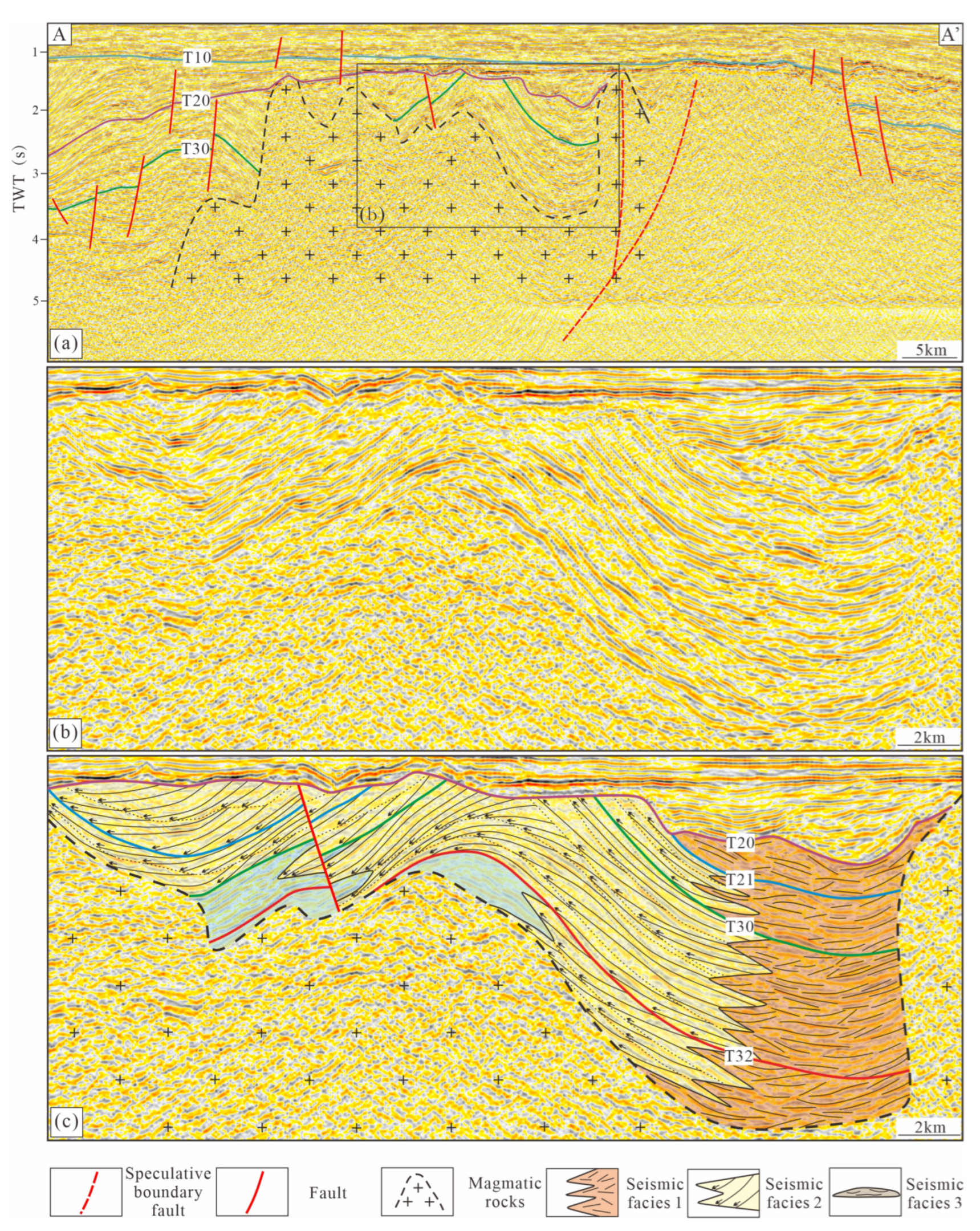
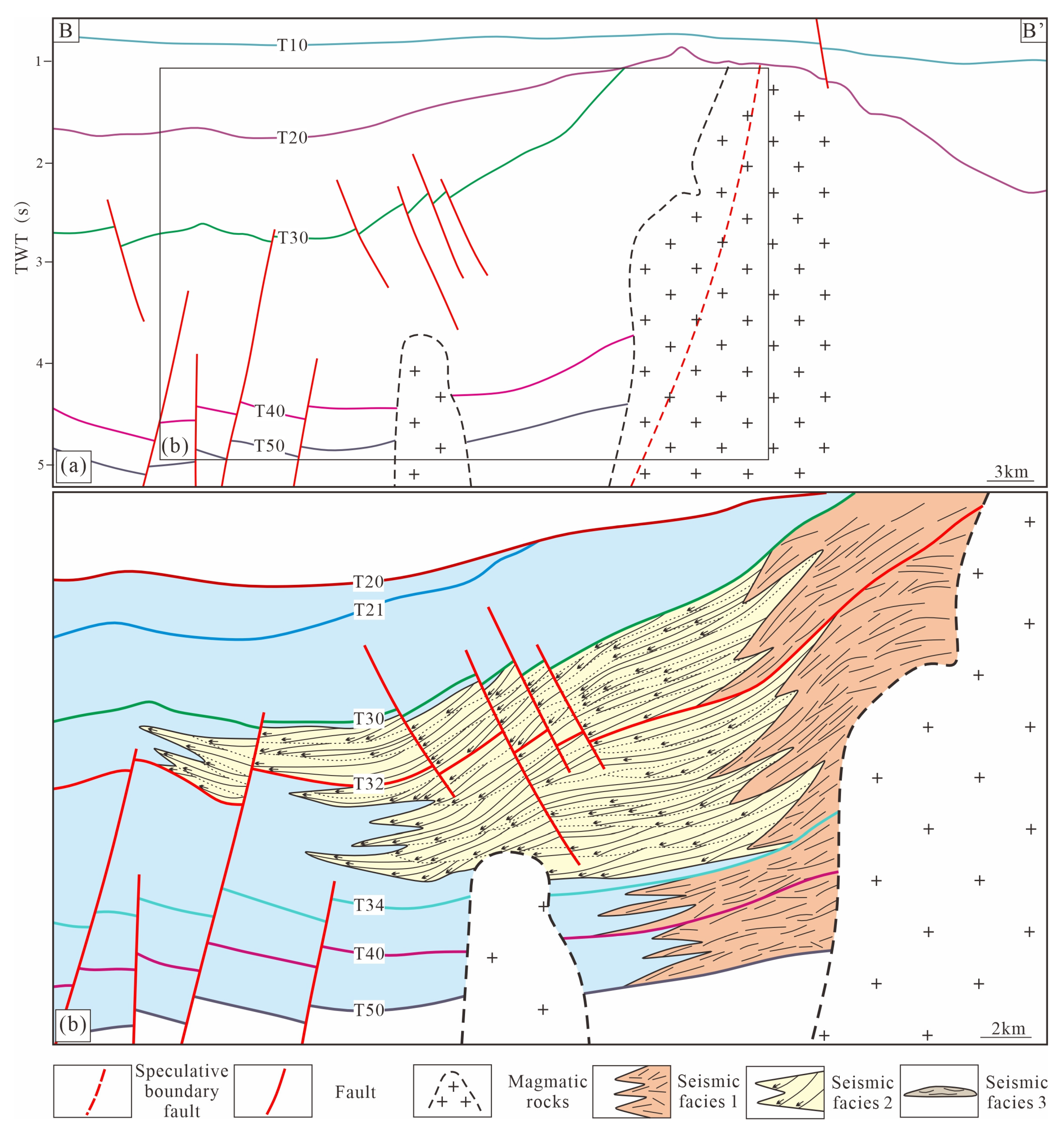

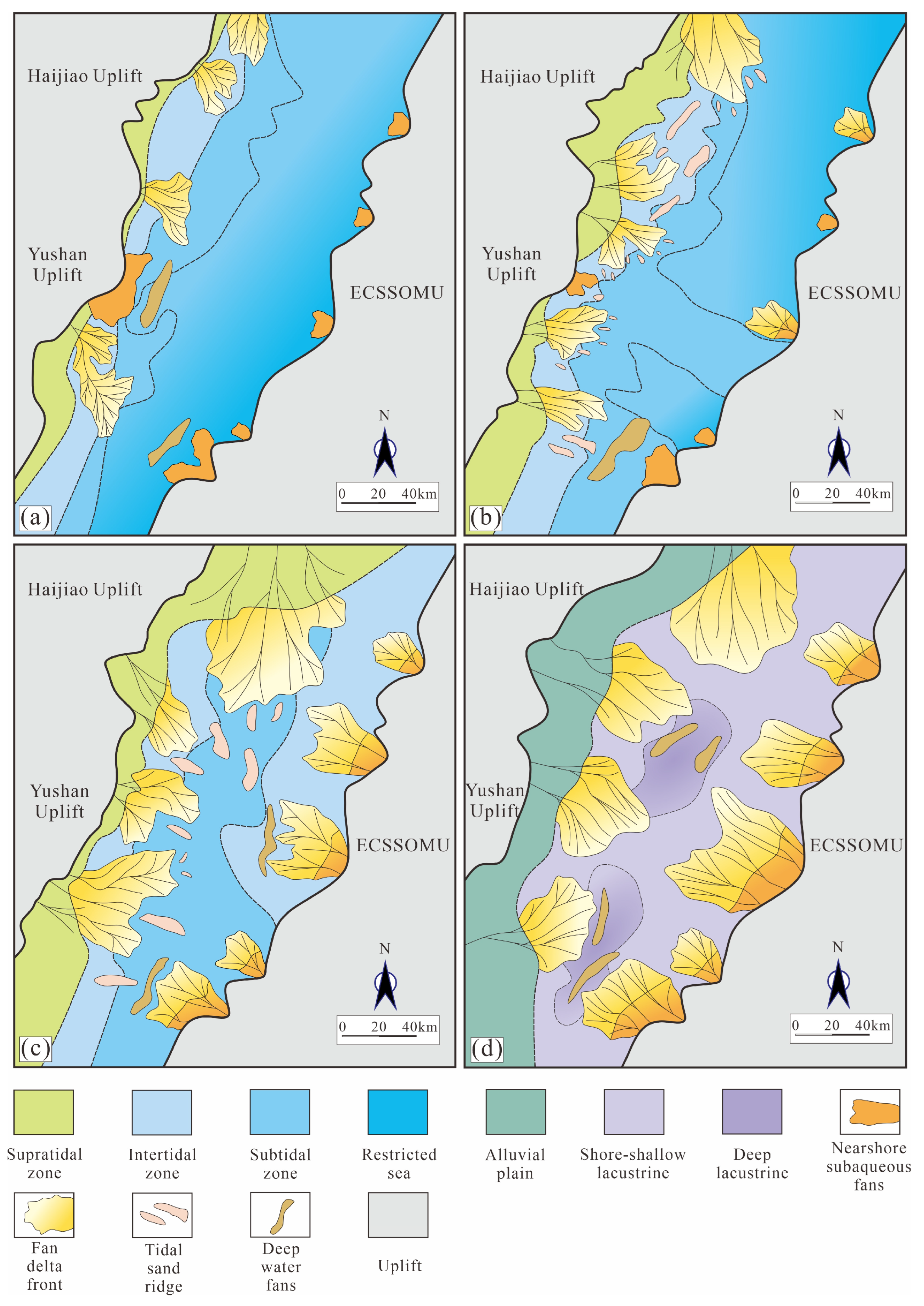
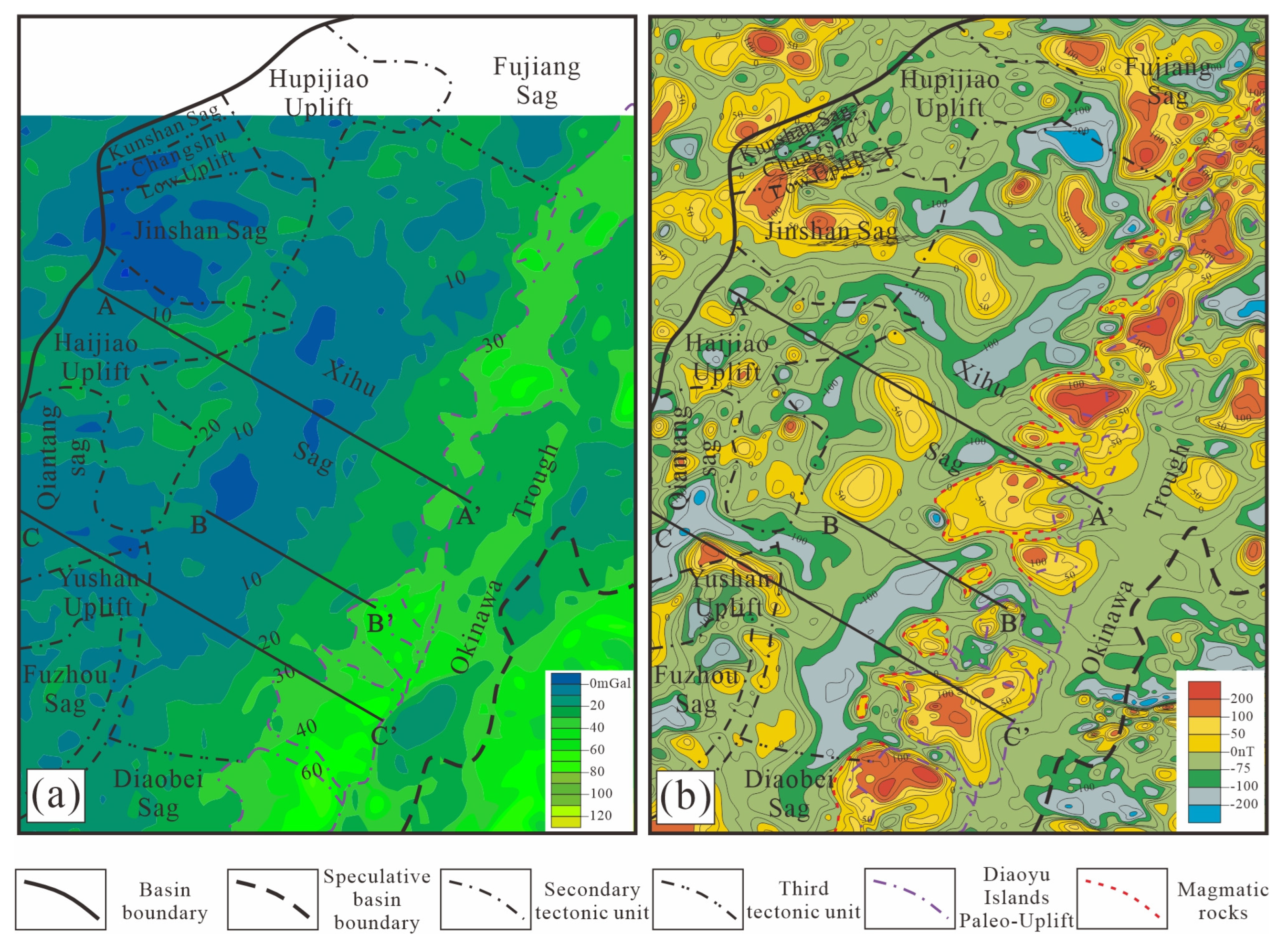
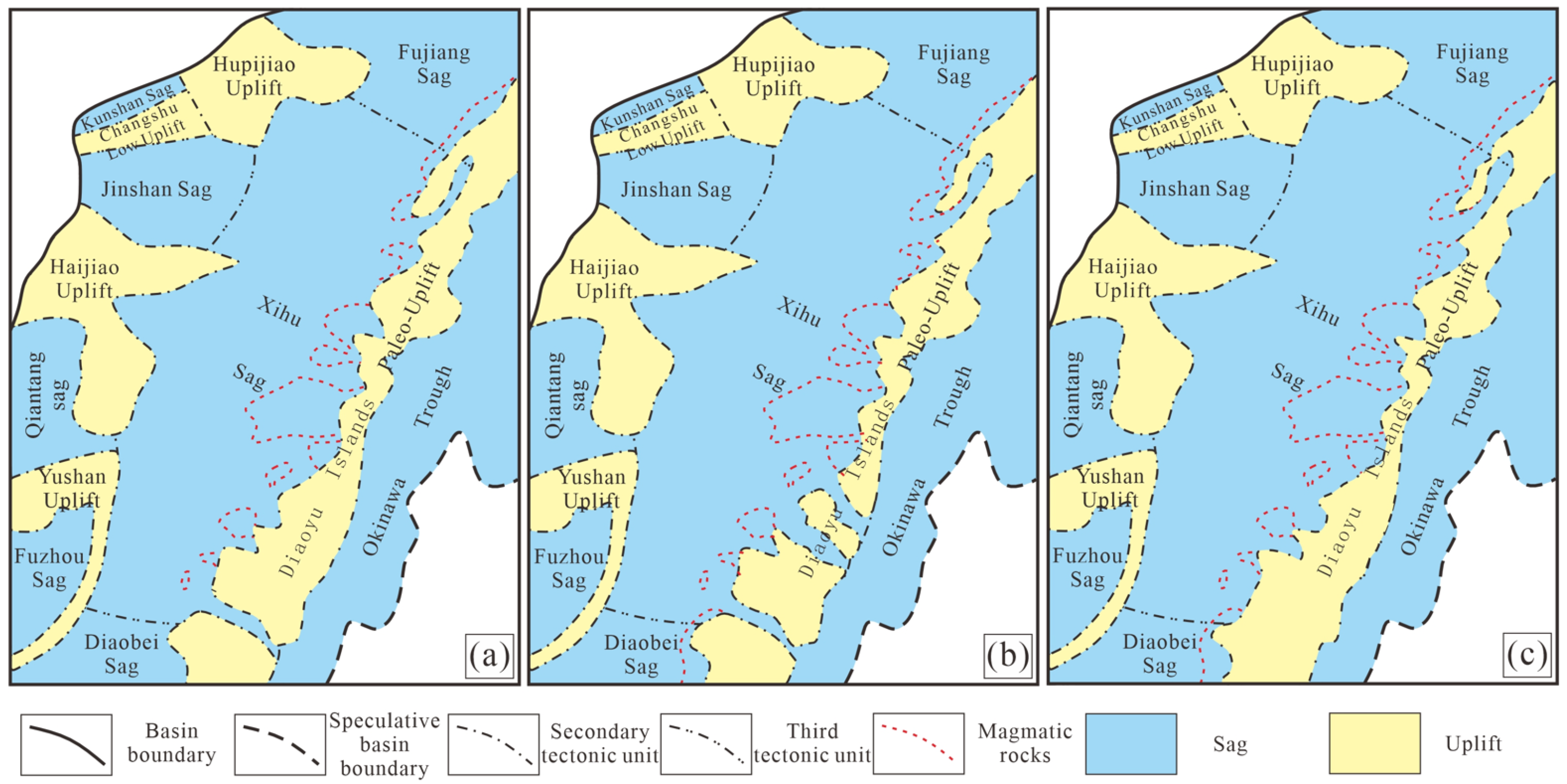


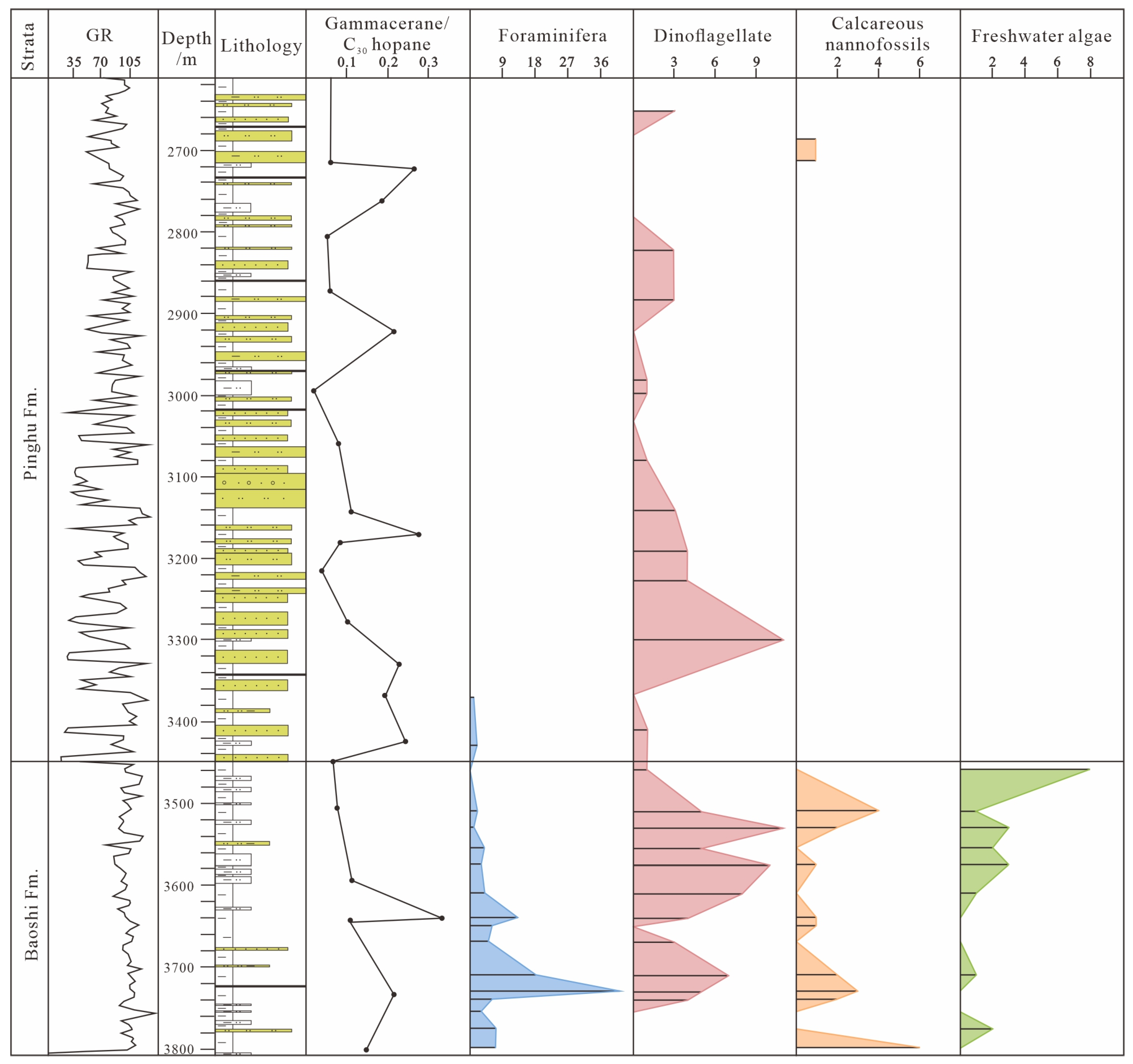
Disclaimer/Publisher’s Note: The statements, opinions and data contained in all publications are solely those of the individual author(s) and contributor(s) and not of MDPI and/or the editor(s). MDPI and/or the editor(s) disclaim responsibility for any injury to people or property resulting from any ideas, methods, instructions or products referred to in the content. |
© 2025 by the authors. Licensee MDPI, Basel, Switzerland. This article is an open access article distributed under the terms and conditions of the Creative Commons Attribution (CC BY) license (https://creativecommons.org/licenses/by/4.0/).
Share and Cite
Zhao, R.; Liu, H.; Jiang, Y.; Chen, H. Paleogene Geomorphy and Formation Process of the Diaoyu Islands Folded-Uplift Belt, East China Sea Basin: Insights of the Dynamics of Subducting Slab on the Control of Tectonic Evolution in Back-Arc Basins. Appl. Sci. 2025, 15, 8878. https://doi.org/10.3390/app15168878
Zhao R, Liu H, Jiang Y, Chen H. Paleogene Geomorphy and Formation Process of the Diaoyu Islands Folded-Uplift Belt, East China Sea Basin: Insights of the Dynamics of Subducting Slab on the Control of Tectonic Evolution in Back-Arc Basins. Applied Sciences. 2025; 15(16):8878. https://doi.org/10.3390/app15168878
Chicago/Turabian StyleZhao, Renjie, Hao Liu, Yiming Jiang, and Hehe Chen. 2025. "Paleogene Geomorphy and Formation Process of the Diaoyu Islands Folded-Uplift Belt, East China Sea Basin: Insights of the Dynamics of Subducting Slab on the Control of Tectonic Evolution in Back-Arc Basins" Applied Sciences 15, no. 16: 8878. https://doi.org/10.3390/app15168878
APA StyleZhao, R., Liu, H., Jiang, Y., & Chen, H. (2025). Paleogene Geomorphy and Formation Process of the Diaoyu Islands Folded-Uplift Belt, East China Sea Basin: Insights of the Dynamics of Subducting Slab on the Control of Tectonic Evolution in Back-Arc Basins. Applied Sciences, 15(16), 8878. https://doi.org/10.3390/app15168878




